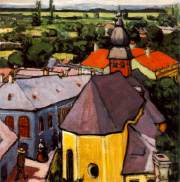

As opposed to objectivity of naturalism and realism which respected reality, expressionism represented the subjectivity of expressions. Expressionist artists projected their sentiments into motifs of the world: they changed or even distorted images according to their emotional intentions. Emotional charges appeared in dramatic colours and strong contrasts, as in romanticism. While romanticism was a typical style of the 19th century, expressionism was present all through the 20th century, it flourished as an art school in the early 20th century.
Expressionism influenced the styles of László Mednyánszky (Stormy Landscape, c. 1915), Tivadar Csontváry Kosztka (The Solitary Cedar, 1907), József Koszta (Drying Clothes 1920s), János Tornyai, János Vaszary (Riders in the Park, 1919), Sándor Ziffer (The Morgó Valley, 1923), Lajos Tihanyi (Landscape, 1908; View of a Street at Nagybánya, 1908), Róbert Berény (Capri szigetéről, 1913), Bertalan Pór, Károly Kernstok (Autumn Light, 1922), Dezső Orbán, József Nemes Lampérth (Landscape, 1917), János Mattis Teutsch (Landscape, 1910) and Vilmos Perlrott-Csaba (Street in Paris, c. 1930) during their lives.